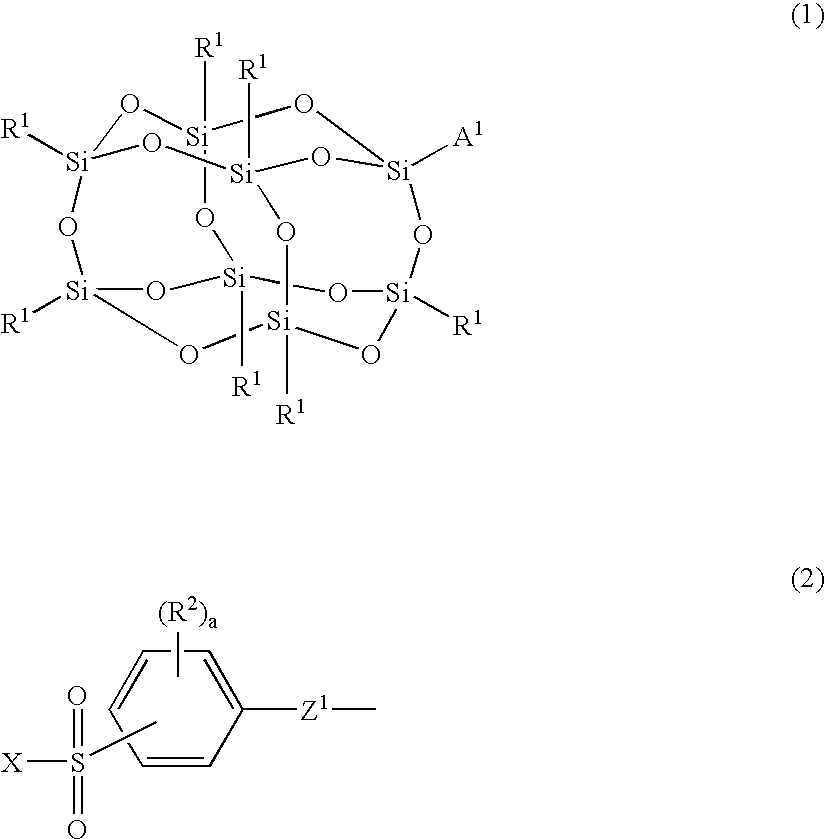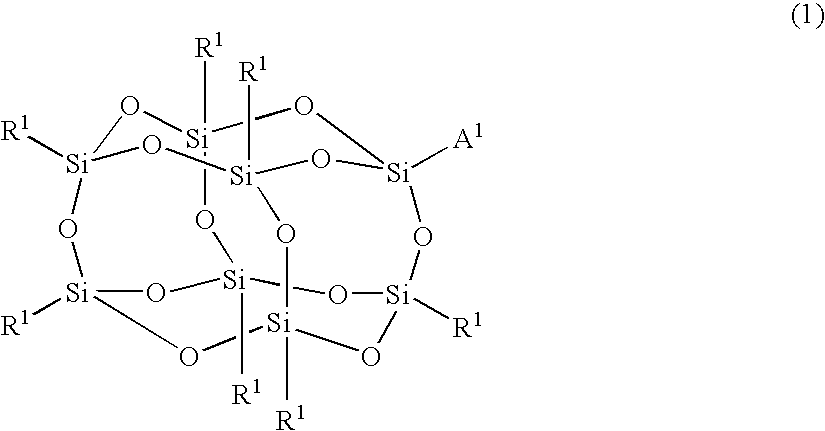Silicon compound
- Summary
- Abstract
- Description
- Claims
- Application Information
AI Technical Summary
Benefits of technology
Problems solved by technology
Method used
Image
Examples
example 1
Synthesis of Polyphenylsilsesquioxane (Compound A)
[0145] A four neck separable flask having a content volume of 2 liter equipped with a reflux condenser, a thermometer and a dropping funnel was charged with ice and water (640.7 g) and toluene (200 g), and the inside of the flask was cooled to 0° C. while stirring. Next, a mixed solution of phenyltrichlorosilane (211.5 g) and toluene (130 g) dried on molecular sieves for a whole day and nigh was dropwise added thereto in one hour so that a temperature of the inside of the flask did not exceed 2° C. Then, after stirring at a room temperature for 30 minutes, the solution was washed with refined water, and toluene was distilled off under reduced pressure to obtain a solid compound A (120.7 g). The compound A had a weight average molecular weight of about 3100.
Synthesis of Sodium-Containing Phenylsilsesquioxane Compound (Compound B)
[0146] A 500 ml-four neck flask equipped with a reflux condenser and a thermometer was charged with the ...
example 2
Introduction of Trimethylsilyl Group into Compound B (Compound C)
[0147] A four neck flask of 200 ml equipped with a reflux condenser was charged with the compound B (2.0 g) obtained in Example 1, toluene (100 g), triethylamine (1.7 g) and trimethylchlorosilane (1.4 g), and the mixture was stirred at a room temperature for 2 hours by means of a magnetic stirrer. After finishing the reaction, it was washed with refined water and dried under vacuum to obtain a compound C (2.1 g).
[0148] The compound C was subjected to structural analysis by means of 1H-NMR, 13C-NMR, 29Si-NMR, mass spectrometry, X ray crystal structure analysis and IR analysis. It was confirmed from a 1H-NMR chart and a 13C-NMR chart that a phenyl group and a trimethylsilyl group were present in an integral ratio of 7:3. It was confirmed from 29Si-NMR that three kinds of peaks of 11.547 ppm indicating a trimethylsilyl group, −77.574 ppm, −78.137 ppm and −78.424 ppm (all based on tetramethylsilane) having a phenyl group...
example 3
Synthesis of Sodium-Containing Phenylsilsesquioxane Compound (Compound B) Using Phenyltrimethoxysilane as Raw Material
[0149] A four neck flask having a content volume of one liter equipped with a reflux condenser, a thermometer and a dropping funnel was charged with phenyltrimethoxyosilane (99 g), sodium hydroxide (10 g) and 2-propanol (500 ml), and a stirrer bar was put thereinto. Deionized water 11 g was dropwise added thereto from the dropping funnel in about 2 minutes while stirring at a room temperature by means of a magnetic stirrer, and then the flask was heated on an oil bath up to a temperature at which 2-propanol was refluxed. After refluxing was started, stirring was continued for 1.5 hour to complete the reaction. Then, the flask was pulled up from the oil bath and left standing still a night at a room temperature to completely deposit a solid matter produced. The solid matter deposited was filtrated by means of a pressure filter equipped with a membrane filter having a...
PUM
| Property | Measurement | Unit |
|---|---|---|
| Temperature | aaaaa | aaaaa |
| Temperature | aaaaa | aaaaa |
| Temperature | aaaaa | aaaaa |
Abstract
Description
Claims
Application Information
 Login to view more
Login to view more - R&D Engineer
- R&D Manager
- IP Professional
- Industry Leading Data Capabilities
- Powerful AI technology
- Patent DNA Extraction
Browse by: Latest US Patents, China's latest patents, Technical Efficacy Thesaurus, Application Domain, Technology Topic.
© 2024 PatSnap. All rights reserved.Legal|Privacy policy|Modern Slavery Act Transparency Statement|Sitemap



